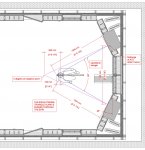miroslav
Cosmic Cowboy
Carl is okay, but he's a bit like John Storyk... a hard-line LEDE/RFZ guy. Not that he doesn't know what he's talking about, but he doesn't in a few areas.
I think some of his stuff is GREAT... It's like everyone in this field; We all have our issues. (except for me) LMAO!! ( you KNOW I'm kidding, right? )
But to say that 'so-and-so' does it this way so it must be correct is actually a logical fallacy; Argument from Authority.
Now, we (studio designers and consultants) are experts, not authorities. We NEED to be questioned. It forces us to grow and get better at what we do.
But, yeah, I completely disagree with Carl's drawing. It can only lead to problems if you don't understand what he is trying to explain there.
I'll explain:
The ANGLE of the speakers is irrelevant. The position is what is critical. Carl was including angle and position. (this is confusing)
1. The speakers must be on lines that are 30 degrees left and right of the direction that the listener faces.
2. The focal direction from the mid or tweeter of the speakers MUST intersect with the EAR! The focal point will be no more than 6" or 15 cm behind the head. (important)
3. Measure the distance from the convergence point (6" behind the head) to the mid or tweeter.
4. Position Left and Right speaker so that their separation distance equals #3.
5. Then the speakers SHOULD be angled outward about 5 degrees from their focal direction. This makes the speakers converge at a point much further behind the head! But this does in no way interfere with the imaging or focus like Carl's drawing WILL.
The horizontal coverage of all professional speakers is just as accurate at 5 degrees off-center as it is ON center. But this allows better room coverage and stereo imaging all over the room (as long as the room is properly treated - again NOT LEDE)
I hope this answers your questions. More details in my upcoming book.
Cheers,
John
OK...I'm digesting your points...but it would really help if you provided a drawing like Carl's...which would make it much easier to see your point and compare to what he's doing....or better yet, take the drawing in my post above...and make the "corrections" you are talking about. I am quite interested to compare your approach to Carl's...and I too like to learn something more, or at least have options to compare.
It appears you're focused on the position of the head at the apex of the triangle...and maybe I'm misreading, but you seem to feel that in the drawing I posted, the head position is too far forward...but I don't think it's more than the 6" you are talking about. The 18" is the distance from the console, not from the triangle apex.
Also....my key point was more about the size of the triangle...the distance between speakers. You really don't make any specific mention of that other than to say they are too far apart....OK...so what's not too far in your opinion, or what's optimal...?
Like I said...if you could draw it out, it would be much easier to see your approach VS Carl's...I can't wait for the book!




